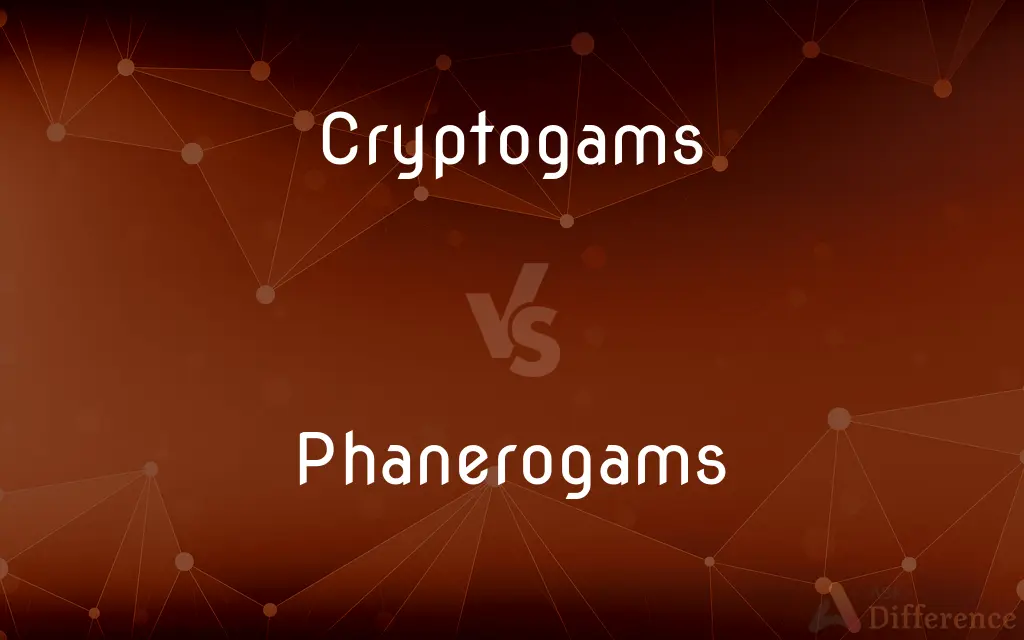Cryptogams vs. Phanerogams — What's the Difference?
Edited by Tayyaba Rehman — By Fiza Rafique — Published on December 27, 2023
Cryptogams are non-seed producing plants like ferns and mosses, while Phanerogams are seed-producing plants, including angiosperms and gymnosperms.

Difference Between Cryptogams and Phanerogams
Table of Contents
ADVERTISEMENT
Key Differences
Cryptogams and Phanerogams represent the two broad categories into which plants are typically classified based on their reproductive structures. Cryptogams include plants that do not produce seeds for reproduction. This category encompasses algae, fungi, lichens, mosses, and ferns. Phanerogams, on the other hand, encompass the seed-producing plants, which have more evolved and visible reproductive organs.
The term "Cryptogam" is derived from Greek, where 'crypto' means 'hidden' and 'gamus' means 'marriage'. This term aptly describes the hidden or concealed reproductive structures in these plants. Phanerogams, conversely, get their name from the Greek words 'phaneros', meaning 'visible', and 'gamus', indicating that their reproductive organs, especially flowers in angiosperms, are easily visible.
Cryptogams can be further subdivided into three categories: Thallophytes (like algae), Bryophytes (like mosses), and Pteridophytes (like ferns). These plants largely rely on spores for reproduction. Phanerogams are categorized into two main groups: Gymnosperms, which have naked seeds, and Angiosperms, which produce seeds enclosed within a fruit. Angiosperms represent the largest group and include most trees, shrubs, and herbaceous plants.
In terms of evolution, Cryptogams represent the earlier and more primitive forms of plant life, showing simple structures and lack of true roots, stems, or leaves in many cases. Phanerogams, being seed-producing, are more advanced and show a higher degree of specialization in terms of structures like roots, stems, leaves, and especially flowers, which are the primary reproductive organs in many of these plants.
Comparison Chart
Reproduction
Spore-producing
Seed-producing
ADVERTISEMENT
Subdivisions
Thallophytes, Bryophytes, Pteridophytes
Gymnosperms, Angiosperms
Reproductive Structures
Hidden or not well-defined
Visible, especially flowers in angiosperms
Evolutionary Status
Primitive forms
More evolved forms
Examples
Algae, Mosses, Ferns
Pine trees (gymnosperms), Rose (angiosperms)
Compare with Definitions
Cryptogams
Primitive plants including algae, fungi, and ferns.
Ferns, as Cryptogams, have a life cycle dependent on spore production.
Phanerogams
The category of plants with defined roots, stems, leaves, and flowers.
The tulip's distinct flower and bulb root system categorize it among Phanerogams.
Cryptogams
Organisms with simple structural organization.
Compared to flowering plants, Cryptogams like algae show simpler organization.
Phanerogams
Plants divided into gymnosperms and angiosperms.
Roses are Phanerogams, falling into the angiosperm category.
Cryptogams
Plants that primarily reproduce via spores.
The life cycle of Cryptogams involves alternation between sporophyte and gametophyte stages.
Phanerogams
Higher order plants with developed reproductive organs.
The blossoming flowers on fruit trees signify their status as Phanerogams.
Cryptogams
Non-seed producing plants with concealed reproductive organs.
Mosses are Cryptogams that reproduce through spores.
Phanerogams
Seed-producing plants with visible reproductive structures.
Oak trees, as Phanerogams, produce acorns as seeds.
Cryptogams
The category of plants without visible flowers or seeds.
Lichens, being Cryptogams, lack the typical flowering structure seen in many plants.
Phanerogams
Plants with a lifecycle involving seeds rather than spores.
Pine trees, being Phanerogams, reproduce using cones and seeds.
Cryptogams
A member of a formerly recognized taxonomic group that included all seedless plants and plantlike organisms, such as mosses, algae, ferns, lichens, and fungi.
Phanerogams
A plant that produces seeds.
Cryptogams
Plural of cryptogam
Phanerogams
Plural of phanerogam
Common Curiosities
Are algae and fungi Cryptogams?
Yes, they fall under the Cryptogam category.
What are the main groups of Phanerogams?
They are divided into gymnosperms and angiosperms.
Which plants fall under Phanerogams?
Seed-producing plants, including gymnosperms and angiosperms.
Which is more evolved: Cryptogams or Phanerogams?
Phanerogams are more evolved, with visible and specialized reproductive organs.
Are roses Cryptogams or Phanerogams?
Roses are Phanerogams, specifically angiosperms.
Can you provide an example of a Cryptogam?
Mosses, which reproduce through spores, are Cryptogams.
What's the primary mode of reproduction for Phanerogams?
They reproduce via seeds.
What are Cryptogams?
They are non-seed producing plants with concealed reproductive structures.
Do Cryptogams produce flowers?
No, they reproduce primarily through spores and lack visible flowers.
What's the significance of seeds in Phanerogams?
Seeds are the primary reproductive units in Phanerogams.
Where does the name Cryptogam come from?
It derives from Greek, meaning "hidden marriage", indicating concealed reproductive structures.
Do Cryptogams have true roots and leaves?
Many Cryptogams lack true roots, stems, or leaves.
What are the reproductive structures in Phanerogams called?
They possess flowers, which are the primary reproductive organs in many Phanerogams.
Are ferns considered Cryptogams?
Yes, ferns are Cryptogams that reproduce via spores.
Which plants have a higher degree of specialization, Cryptogams or Phanerogams?
Phanerogams have a higher degree of specialization in their structures.
Share Your Discovery

Previous Comparison
Oxidation Number vs. Oxidation State
Next Comparison
Bharat Petroleum vs. Hindustan PetroleumAuthor Spotlight
Written by
Fiza RafiqueFiza Rafique is a skilled content writer at AskDifference.com, where she meticulously refines and enhances written pieces. Drawing from her vast editorial expertise, Fiza ensures clarity, accuracy, and precision in every article. Passionate about language, she continually seeks to elevate the quality of content for readers worldwide.
Edited by
Tayyaba RehmanTayyaba Rehman is a distinguished writer, currently serving as a primary contributor to askdifference.com. As a researcher in semantics and etymology, Tayyaba's passion for the complexity of languages and their distinctions has found a perfect home on the platform. Tayyaba delves into the intricacies of language, distinguishing between commonly confused words and phrases, thereby providing clarity for readers worldwide.













































